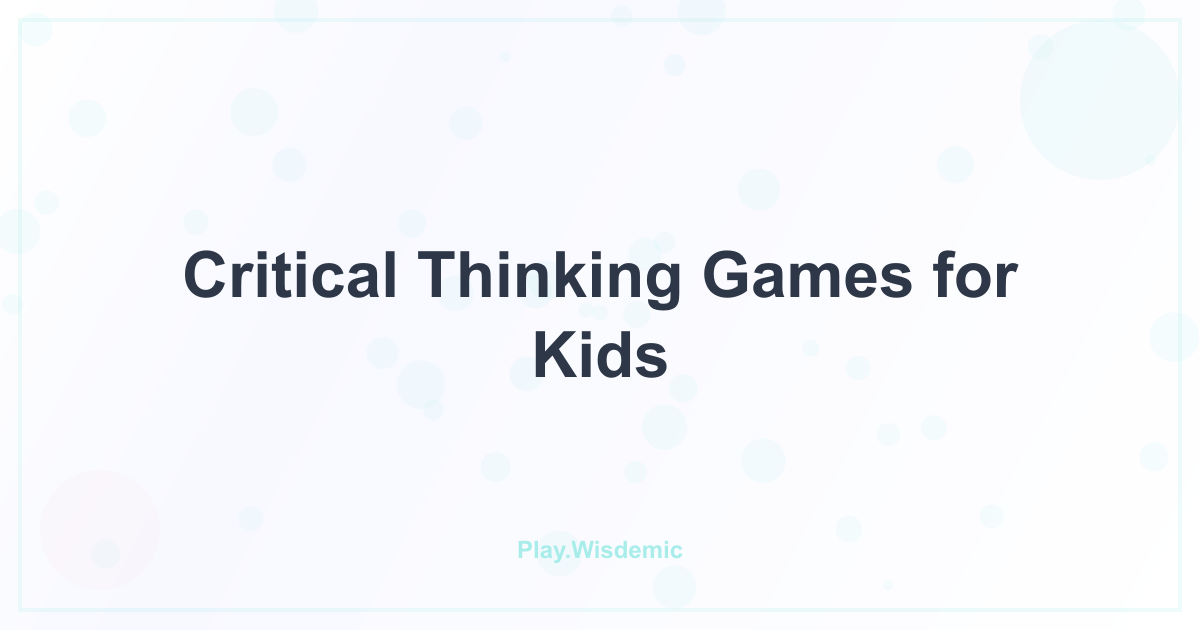In our rapidly changing world, the ability to think critically—to analyze, evaluate, and create solutions—is more valuable than memorizing facts. Critical thinking is indeed like a muscle: the more children exercise it through purposeful play, the stronger their reasoning becomes. As a parent, I've watched my kids transform from accepting everything at face value to asking probing questions that sometimes stump even me. Here's how to nurture those brilliant “what if” minds through games that feel like pure fun.
Why Critical Thinking Skills Shape Future Success
Critical thinking encompasses several interconnected abilities: analyzing information, recognizing patterns, evaluating evidence, and generating creative solutions. Children who develop these skills early show improved academic performance, better social relationships, and increased confidence in facing challenges.
- Academic Advantage: Critical thinkers excel at reading comprehension, math problem-solving, and scientific inquiry.
- Social Intelligence: They better understand different perspectives and navigate complex social situations.
- Emotional Resilience: When faced with setbacks, they generate alternative approaches rather than giving up.
- Future-Ready Skills: Employers consistently rank critical thinking among the most valuable workplace abilities.
Critical Thinking Development by Age
Understanding how critical thinking evolves helps you choose age-appropriate challenges:
Ages 3-4: Foundation Building
- Simple cause-and-effect observations (“What happens if...?”)
- Basic categorization and sorting
- Beginning to ask “why” questions
Ages 5-6: Pattern Recognition
- Identifying sequences and predicting what comes next
- Comparing and contrasting objects or ideas
- Making simple predictions based on evidence
Ages 7-8: Logical Reasoning
- Understanding multiple perspectives on the same situation
- Drawing conclusions from given information
- Recognizing when additional information is needed
6 Types of Critical Thinking Games
1. Deduction Games
These games require children to use clues to reach logical conclusions:
- What's Missing? Arrange 5-7 objects, have child close eyes, remove one, and let them deduce which disappeared.
- Mystery Box: Place an object in a container; child asks yes/no questions to identify it.
- Logic Lanes on Play.Wisdemic: Digital puzzles where multiple solution paths reward flexible thinking.
2. Pattern Analysis
- Sequence Builders: Start a pattern (red, blue, red, blue...) and have child continue it.
- Rule Detectives: Sort objects by a secret rule; child must discover the sorting criteria.
- Number Patterns: Present sequences like 2, 4, 6, 8... and discuss the underlying rule.
3. Perspective-Taking
- Story Flip: Retell familiar fairy tales from the villain's perspective.
- Multiple Endings: Read a story partway through, then brainstorm different possible conclusions.
- Role Reversal: Have child explain why a character made specific choices.
4. Hypothesis Testing
- Prediction Games: “What will happen if we mix these colors?”
- Experiment Design: Child creates simple tests to answer questions like “Which paper airplane flies farthest?”
- Evidence Collection: Gather data to support or refute predictions.
5. Creative Problem-Solving
- Alternative Uses: Brainstorm unusual ways to use everyday objects (paperclip, newspaper, etc.).
- Constraint Challenges: “Build the tallest tower using only these 10 blocks.”
- Resource Optimization: “How can we share these 3 cookies among 4 people fairly?”
6. Evaluation & Analysis
- Compare & Contrast: Analyze similarities and differences between characters, objects, or situations.
- Evidence Weighing: Present competing explanations and discuss which has stronger support.
- Quality Assessment: Evaluate solutions based on specific criteria (effectiveness, creativity, practicality).
Bringing Critical Thinking Into Daily Life
The most powerful critical thinking development happens during everyday moments. When my eight-year-old asks why we take different routes to school, we explore factors like traffic, construction, and time constraints. When my four-year-old wonders why some leaves change color, we investigate together and form hypotheses.
Last month, our family faced a scheduling conflict: soccer practice and a birthday party at the same time. Instead of making the decision myself, I facilitated a family discussion where we weighed priorities, considered alternatives, and reached a solution everyone felt good about. My son later applied similar reasoning when choosing between conflicting friend activities.
Creating a Critical Thinking-Friendly Environment
- Embrace Questions: When children ask “why,” resist the urge to give immediate answers. Instead, ask “What do you think?”
- Model Thinking Aloud: Verbalize your own reasoning process: “I'm choosing this route because...”
- Celebrate Mistakes: Frame errors as learning opportunities rather than failures.
- Encourage Multiple Solutions: Ask “What's another way we could solve this?”
- Practice Patience: Critical thinking takes time; avoid rushing to conclusions.
FAQ
How can I tell if my child is developing critical thinking skills?
Look for increased questioning, consideration of multiple perspectives, and creative problem-solving in daily situations. They might start challenging assumptions or proposing alternative solutions.
What if my child gets frustrated with thinking games?
Start with shorter, simpler challenges and gradually increase complexity. Emphasize the thinking process over getting “right” answers.
Can critical thinking games be competitive?
Healthy competition works when you emphasize reasoning quality over speed or accuracy. Consider team-based challenges where children collaborate rather than compete.
How often should we practice critical thinking?
Brief daily interactions (5-10 minutes) are more effective than long, formal sessions. Integration into routine activities works best.
Are digital critical thinking games as effective as hands-on activities?
Both have value. Digital games like those on Play.Wisdemic can present complex scenarios efficiently, while hands-on activities engage multiple senses and real-world application.
Ready to watch those “aha!” moments multiply? Explore our critical-thinking game collection on Play.Wisdemic and discover how digital puzzles can complement your family's reasoning adventures!
